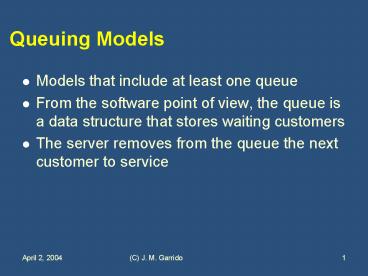Queuing Models - PowerPoint PPT Presentation
1 / 26
Title: Queuing Models
1
Queuing Models
- Models that include at least one queue
- From the software point of view, the queue is a
data structure that stores waiting customers - The server removes from the queue the next
customer to service
2
Basic Categories of Queuing Models
- Single-server models
- Multi-server models
- Queuing networks
3
Examples of Queuing Models
- Computer systems
- Communication systems, networks
- Teller facilities in a bank
- Production systems
- Transport and materials handling
- Repair and maintenance systems
4
Service Stations
- A queuing model consists of a number of
facilities and interconnecting queues. Each
facility, or service station, consists of one or
more servers. - For these types of systems, it is very common in
practice to use exponentially distribution for
inter-arrival periods and for service periods.
5
Types of Queuing Models
- Single-server, single-queue
- Multi-server, single-queue
- Multi-server, multi-queue
- Multi-server, multi-queue with priorities
- Multi-server, multi-queue with priorities and
preemption.
6
Multiple Servers Single Queue
- Any of the servers available can provide service
demanded by a customer - A server removes the next customer from the head
of the customer queue - One or more servers can be idle, waiting for
customers to arrive
7
Carwash Model With Multiple Machines
8
General Description of the Model
- This model has K machines (servers)
- A customer can receive service from any machine
(any server) - A customer waits in the customer queue until it
is at the head of the queue and a machine becomes
available - The machine removes the customer from the head of
the queue and starts to service it
9
Idle Servers
- Idle servers are organized in a server queue
- A server joins a queue of idle servers if there
are no customers - An arriving customer enters the input queue and
reactivates the server at the head of the server
queue. If there are no servers available, the
customer just waits
10
Models With Multiple Servers and Multiple Queues
11
Multi-Server Multi-Queue Model
- Every server has its own queue of customers
- An arriving customer selects the server with the
smallest queue - Alternatively, an arriving customer randomly
selects a server.
12
Multi-Server Multi-Queue Model with Preemption
- Every customer has a priority
- An arriving customer can interrupt the service of
another customer with a lower priority - the interrupted customer is returned to the head
of his queue, this customer is the one with the
lowest priority and that started most recently.
13
Performance Measures
- The average number of customers in the system
- The average number of customers in the queue(s)
(i.e., that are waiting) - The average period that a customer spends in the
system - The average period that a customer spends in the
customer queue waiting - The server utilization
14
Queuing Networks
- Consists of two or more interconnected stations
- The output from a station are connected to input
of another station - Each station has one or more servers and its
queues - Each station provides a different service
15
Service in a Queuing Network
- Customers enter the network at any of several
entry stations - Customers are routed through the network
demanding service from different stations - Customers can exit from any of several exit
stations
16
A Queuing Network
17
Models With Priorities
- Customers are grouped into classes or types
- Each customer class has its own priority, and
workload parameters (e.g., arrival rate and a
service demand) - The customers wait in a priority queue, with
highest priority closest to the head - A server removes the customer with the highest
priority from the queue
18
Examples
- Medical service systems
- Computer communication networks
- Operating systems
- Car-wash systems for different types of vehicles
19
Priority Queue
- A queue that holds customers by priority
- The queue discipline is ordering of the customers
by priority - Customers with the highest priority are always at
the head of the queue
20
Model With Priorities
21
Priority Queues in PsimJ
- To declare a priority queue, use class Pqueue
- public static Pqueue car_queue // for car
objects - To create object car_queue (passive object) with
K different priorities - car_queue new Pqueue (CarQ, K)
- In PsimJ, the highest priority is 0
22
Priorities For the Car Objects
- There is an arrivals object for every customer
class - Each arrivals object creates car objects for the
corresponding priority - A car object gets its priority when created (in
the constructor) - A car object joins the corresponding priority
queue to wait for service
23
Defining and Using Car Priority
The constructor in class Car public Car(String
name, int type, double dur)
... int my_priority type // type (priority)
of car set_prio (my_priority) // assigns its
priority
In the Main_body of class Car // this object
joins the priority queue car_queue.into(this)
24
Results of a Simulation Run
- The trace, which is the sequence of events that
occur during the simulation run - Performance measures for every priority
- Throughput
- Average wait period
- other measures
25
Multi-Server Model with Priorities
- Every customer has a priority and joins the
priority queue - An server gets the customer from the queue with
highest priority - If there are no customers, and server joins a
server queue and becomes idle
26
Multiple Servers With Priority































